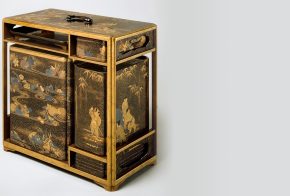Text and film footage describe the challenges of lacquer production — from extracting sap to decorating with gold and silver powder. Find out about the toxic liquid used to make lacquer (extracted from a tree related to poison oak), as well as the regimented, climate-sensitive steps involved in its creation.
As you’ll learn, completing even a plain lacquered surface with only simple decorations is a lengthy, tedious and often precarious process, since any mistake can ruin an entire piece. Producing meticulously embellished works like those on view in Japanese Lacquerware requires the highest level of craftsmanship.
As in other countries where lacquerware has traditionally been produced, the process is fundamentally quite basic. An object is formed from wood, sometimes leather, paper, or basketry. Lacquer is applied to seal and protect the object, and then decoration is added. Generally, three coats (undercoat, middle-coat, and final coat) are used, the final coat sometimes being clear rather than black lacquer, in order to allow decorations to show through.
Alongside the red and black lacquers, it is common to see the use of inlay, often seashells or similar materials, as well as mica or other materials. The application of gold powder is known as maki-e, and is a very common decorative element.
A few examples of traditional techniques follow:
- Ikkanbari (一閑張), also known as harinuki (張貫) is one common technique used to make tea wares. Invented by Hiki Ikkan in the early 17th century, the process involves the application of layers of lacquer to paper shaped in a mold.
- Iro-urushi (色漆), literally “color lacquer”, was created by adding pigments to clear lacquer. The limits of natural pigments allowed only five colors (red, black, yellow, green and brown) to be used up until the 19th century, when various innovations appeared, along with the later introduction of Western artificial pigments. Shibata Zeshin was a major innovator in this field, using not only color but also other substances mixed in with his lacquer to achieve a wide variety of effects, including the simulated appearance of precious metals, which were heavily restricted from artistic use at the time due to government concerns over excessive extravagance.
- Shunkei-nuri (春慶塗), supposedly developed by a 14th-century monk named Shunkei, was a popular method in the 17th century of using clear lacquer to allow the natural appearance of the wood underneath to show through.
- Urushi-hanga(漆絵版画), developed by Hakuo Iriyamaproducing a printing plate from dry lacquer, that was carved and finally used like a block print but instead of traditional printing colors with pigmented lacquer.
